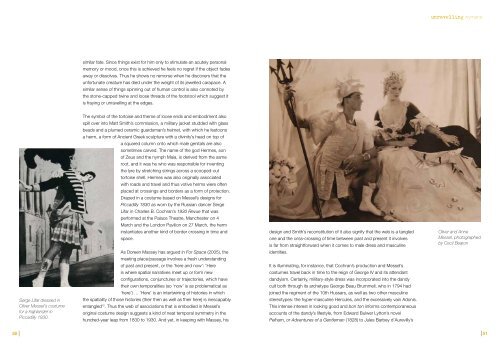Oliver Messel between Past and Present • Paul Jobling
Oliver Messel between Past and Present • Paul Jobling
Oliver Messel between Past and Present • Paul Jobling
Create successful ePaper yourself
Turn your PDF publications into a flip-book with our unique Google optimized e-Paper software.
Serge Lifar dressed in<br />
<strong>Oliver</strong> <strong>Messel</strong>’s costume<br />
for a highl<strong>and</strong>er in<br />
Piccadilly 1830<br />
similar fate. Since things exist for him only to stimulate an acutely personal<br />
memory or mood, once this is achieved he feels no regret if the object fades<br />
away or dissolves. Thus he shows no remorse when he discovers that the<br />
unfortunate creature has died under the weight of its jewelled carapace. A<br />
similar sense of things spinning out of human control is also connoted by<br />
the stone-capped twine <strong>and</strong> loose threads of the footstool which suggest it<br />
is fraying or unravelling at the edges.<br />
The symbol of the tortoise <strong>and</strong> theme of loose ends <strong>and</strong> embodiment also<br />
spill over into Matt Smith’s commission, a military jacket studded with glass<br />
beads <strong>and</strong> a plumed ceramic guardsman’s helmet, with which he festoons<br />
a herm, a form of Ancient Greek sculpture with a divinity’s head on top of<br />
a squared column onto which male genitals are also<br />
sometimes carved. The name of the god Hermes, son<br />
of Zeus <strong>and</strong> the nymph Maia, is derived from the same<br />
root, <strong>and</strong> it was he who was responsible for inventing<br />
the lyre by stretching strings across a scooped-out<br />
tortoise shell. Hermes was also originally associated<br />
with roads <strong>and</strong> travel <strong>and</strong> thus votive herms were often<br />
placed at crossings <strong>and</strong> borders as a form of protection.<br />
Draped in a costume based on <strong>Messel</strong>’s designs for<br />
Piccadilly 1830 as worn by the Russian dancer Serge<br />
Lifar in Charles B. Cochran’s 1930 Revue that was<br />
performed at the Palace Theatre, Manchester on 4<br />
March <strong>and</strong> the London Pavilion on 27 March, the herm<br />
instantiates another kind of border crossing in time <strong>and</strong><br />
space.<br />
As Doreen Massey has argued in For Space (2005), the<br />
meeting place/passage involves a fresh underst<strong>and</strong>ing<br />
of past <strong>and</strong> present, or the ‘here <strong>and</strong> now’: ‘Here<br />
is where spatial narratives meet up or form new<br />
configurations, conjunctures or trajectories, which have<br />
their own temporalities (so ‘now’ is as problematical as<br />
‘here’) … ‘Here’ is an intertwining of histories in which<br />
the spatiality of those histories (their then as well as their here) is inescapably<br />
entangled’ 2 . Thus the web of associations that is embodied in <strong>Messel</strong>’s<br />
original costume design suggests a kind of neat temporal symmetry in the<br />
hundred-year leap from 1830 to 1930. And yet, in keeping with Massey, his<br />
design <strong>and</strong> Smith’s reconstitution of it also signify that the web is a tangled<br />
one <strong>and</strong> the criss-crossing of time <strong>between</strong> past <strong>and</strong> present it involves<br />
is far from straightforward when it comes to male dress <strong>and</strong> masculine<br />
identities.<br />
It is illuminating, for instance, that Cochran’s production <strong>and</strong> <strong>Messel</strong>’s<br />
costumes travel back in time to the reign of George IV <strong>and</strong> its attendant<br />
d<strong>and</strong>yism. Certainly, military-style dress was incorporated into the d<strong>and</strong>y<br />
cult both through its archetype George Beau Brummell, who in 1794 had<br />
joined the regiment of the 10th Hussars, as well as two other masculine<br />
stereotypes: the hyper-masculine Hercules, <strong>and</strong> the excessively vain Adonis.<br />
This intense interest in looking good <strong>and</strong> bon ton informs contemporaneous<br />
accounts of the d<strong>and</strong>y’s lifestyle, from Edward Bulwer Lytton’s novel<br />
Pelham, or Adventures of a Gentleman (1828) to Jules Barbey d’Aurevilly’s<br />
unravelling nymans<br />
<strong>Oliver</strong> <strong>and</strong> Anne<br />
<strong>Messel</strong>, photographed<br />
by Cecil Beaton<br />
50 51

















